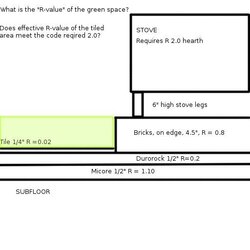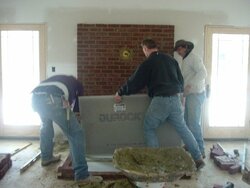Webmaster said:
Goose, caution would say that we should work the other way around. Unless Hardi says it is OK for this use, then it isn't. Again, the question is not whether it will work, but whether it meets any listing requirements. Here are the exact words from Dura and WB:
Wonderboard
"UL Rated Report No. 7L30 for floor protector and wall shield."
Durock
"also adaptable for high-heat areas like fireplace fronts and UL-listed wall shield/floor protectors. DUROCK"
From the HardieBacker FAQ
HardieBacker boards are recognized as non-combustible, when tested according to ASTM E 136
. How ASTM E 136 compares to UL 7L30, I don't know. The FAQ also says it IS acceptable for fireplace fronts. The message you pointed at earlier in this thread saying it wasn't OK was also talking about BBQ's, and from the context of the quote it appeared the issue was the exterior application, not the non-combustiblity.
I have not seen any information of this type on the hardie site. There is a big different between fire resistant and approval for hearths.
I think some of your questions are already answered - some of the sites have guides to the weight bearing capability. R values can always be added together, that is the way it works.
Perhaps, but if you say the other application data is not relevant, then I'm assuming this should be confirmed as well.
Hardie does show a smoke generation index of 5, which I assume is because of the cellulose burning.
Possible, the question is what does that number mean in comparison to other products - what is the SGI for Durorock and Wonderboard for instance?
Maybe we will hear from them...but will they have a test report like the others and specifically mention it in their instructions? Or will some factory phone person tell us something as silly as the last one "no R value, heat passes right through it".
Since the other two products are available almost anywhere.....I guess I am questioning why use something without this specific listing? As to use on fireplace fronts, firewalls and such, that is a different application.
Also, Durock has 30 year interior warranty....I though I saw 10 on the Hardie.
Hardie appears to be a lighter weight product, and be easier to work with (or so Elk says) It is available in 1/4" or 1/2" thickness, the others appear to be only availale in 1/2". It has a slightly higher R-value (0.260, vs 0.200 for the others) it claims higher strength than the others.
HardieBacker's Website says it has a 20 year transferable warranty, although reading it I would not consider it a highly valuable sales point - it's only good for the cost of the product, and is pro-rated so the amount drops every year, and (like lots of warrantees) is loaded with tons of exceptions and loopholes. I'd expect the others to be similar.
[/quote]My guess on this whole thing is that it would pass the tests, but they have not submitted it for such. Another one of those thousands of situations that fall between the cracks.[/quote]
Perhaps... They also may not have realized that this is an important enough market segment to put the data on their website.
Additional data - pulled from the Donor stove install where Elk failed the first inspection because of a missed clearance and fixed it with HardieBacker - Granted, this was overhead and not underfoot, but...
"I must say Hardibacker board is much easier to work with that cement board lighter and cuts better
Thermal Values (ASTM C177)
1/4” HardieBacker and 1/4” HardieBacker EZ Grid® cement board Thermal Conductivity: k-value 7.80 Btu/ft2 x h x °F
1/2” HardieBacker cement board Thermal Conductivity: k-value 20.07 Btu/hr-ft2 - °F
1/4” HardieBacker and 1/4” HardieBacker EZ Grid® cement board Thermal Resistance: R-value 0.13 ft2 x h x °F/Btu
1/2” HardieBacker cement board Thermal Resistance: R-value 0.05 hr-ft2 - °F/Btu
Non-Combustibility
When tested in accordance with ASTM Method E-136, HardieBacker cement board is recognized as a non-combustible building material in NER-405.
Surface Burning Characteristics
When tested in accordance with ASTM method E-84: Flame Spread – 0, Fuel Contributed – 0, Smoke Developed – 5.
Fire Rated Assemblies
Hardibacker cement board may be used as a component in one-hour fire-resistive wall construction; consult NER-405 and Intertek-ETLSemko website listings for recognized assemblies, or contact James Hardie’s Technical Services at 1-800-9HARDIE (1-800-942-7343).
At any rate, I'm sending an e-mail to Hardie Tech support, will see what they have to say. In the meantime I've added a blurb to the Wiki Article saying that there are questions about the suitability of HardieBacker and it is not currently reccomended. (BTW, I need some help getting the table of materials in it right - looks fine when I'm in edit mode, but looks like CHIT in the display mode...)
Gooserider




